This article relies largely or entirely on a single source .(July 2021) |
Chempakaraman or Chembakaramen was a title of honour bestowed by the Kingdom of Travancore to individuals for faithful service to the kingdom in public service. [1]
This article relies largely or entirely on a single source .(July 2021) |
Chempakaraman or Chembakaramen was a title of honour bestowed by the Kingdom of Travancore to individuals for faithful service to the kingdom in public service. [1]

It was during the reign of Marthanda Varma that an order akin to that of knighthood, was established as a kind of stimulus to those in the public service. Distinguished services were rewarded by this honor. It was denominated Chempakaraman. [1]
The recipient of this distinguished honor when selected, is presented before the Maha Raja on a propitious day fixed for the ceremonial. The Maharaja then, delivering a short speech in the presence of all the officers of State, expressive of the satisfaction afforded by the knight, elect to justify king's bestowing such an exalted title on him, gives him some special presents and names him by the title Chempakaraman after his name. The knight then proceeds to the gate of the palace followed by the prime minister and other officials. At the gate, in a hall attached to it, takes place the subsequent ceremony which consists in the presentation of a new piece of a peculiar kind of silk, eight yards long, called Veeravaly Pattu and the wearing of a suit of new clothes. The knight being dressed properly, after the Travancore fashion, one end of the silk is tied round his head, leaving the other end to the extent of two and a half or three yards loose, like the train of a long robe. He is then placed on an elephant and behind him three nobles or other persons invested with similar titles, seats themselves bearing the train of the knight's turban. The knight then carried in procession, accompanied by a native band, a small detachment of military, together with all the State peons, kariakkar, and other servants. The procession moves round the four streets inside the fort, and returns to the gate, where the knight dismounts from the elephant and proceeds with the prime minister who is waiting for him to the latter's seat where the knight then enjoys the privilege of being seated with the minister. The new knight is then presented with a quantity of betel leaves and areca nuts, together with a few ripe limes in a silver plate, called thattom or thampalam, and thus ends the ceremony. From this day the title Chempakaraman Pillai is always added to his name. [1]

The Kingdom of Travancore, also known as the Kingdom of Thiruvithamkoor or later as Travancore State, was an Indian kingdom that lasted from c. 1729 until 1949. It was ruled by the Travancore Royal Family from Padmanabhapuram, and later Thiruvananthapuram. At its zenith, the kingdom covered most of the south of modern-day Kerala and the southernmost part of modern-day Tamil Nadu with the Thachudaya Kaimal's enclave of Irinjalakuda Koodalmanikyam temple in the neighbouring Kingdom of Cochin. However Tangasseri area of Kollam city and Anchuthengu near Attingal in Thiruvananthapuram were parts of British India.
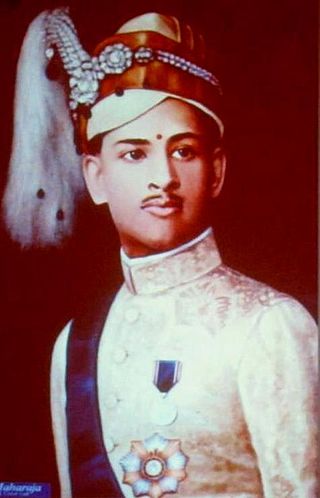
Sree Padmanabhadasa Sree Chithira Thirunal Balarama Varma, popularly known as Sree Chithira Thirunal, was the last ruling Maharaja of the Indian princely state of Travancore, in southern India until 1949 and later the Titular Maharajah of Travancore until 1991. His reign is known for several notable reforms that have indelible impact on the society and culture of Kerala.
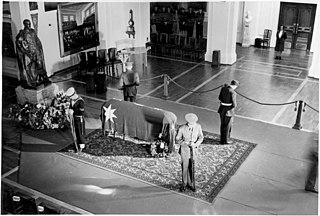
A state funeral is a public funeral ceremony, observing the strict rules of protocol, held to honour people of national significance. State funerals usually include much pomp and ceremony as well as religious overtones and distinctive elements of military tradition. Generally, state funerals are held in order to involve the general public in a national day of mourning after the family of the deceased gives consent. A state funeral will often generate mass publicity from both national and global media outlets.

Travancore–Cochin, or Thiru–Kochi, was a short-lived state of India (1949–1956). It was originally called United State of Travancore and Cochin following the merger of two former kingdoms, Travancore and Cochin on 1 July 1949. Its original capital was Thiruvananthapuram. It was renamed State of Travancore–Cochin in January 1950. Travancore merged with erstwhile princely state of Cochin to form Travancore–Cochin in 1950. The five Tamil-majority Taluks of Vilavancode, Kalkulam, Thovalai, Agastheeswaram, and Sengottai were transferred from Travancore-Cochin to Madras State in 1956. The Malayalam-speaking regions of the Travancore–Cochin merged with the Malabar District and the Kasaragod Taluk of South Canara district in Madras State to form the modern Malayalam-state of Kerala on 1 November 1956, according to the States Reorganisation Act, 1956 passed by the Government of India.
Paliath Achan or Paliyath Achan is the name given to the male members of the Paliam royal family, a Nair/Menon chieftain family from the Indian state of Kerala who were elevated to the status of royalty by the Rajah of Kingdom of Cochin (Kerala), since the family figured prominently in the history of the region.

An enthronement is a ceremony of inauguration, involving a person—usually a monarch or religious leader—being formally seated for the first time upon their throne. Enthronements may also feature as part of a larger coronation rite.

Elephants found in Kerala, the Indian elephants, are one of three recognized subspecies of the Asian elephant. Since 1986, Asian elephants have been listed as endangered by IUCN as the population has declined by at least 50% over the last three generations, estimated to be 25,600 to 32,750 in the wild. The species is pre-eminently threatened by habitat loss, degradation and fragmentation. Along with a large population of wild elephants, Kerala has more than seven hundred captive elephants. Most of them are owned by temples and individuals. They are used for religious ceremonies in and around the temples, and some churches, and a few elephants work at timber yards.

Kunnathur Kesavan Raman Pillai, also known as Raja Kesavadas was the Dewan of Travancore during the reign of Dharma Raja Karthika Thirunal Rama Varma. He is well known for his military tactics and administrative acumen. He was the mastermind in developing the Alappuzha town.

Velayudhan Chempakaraman Thampi ofThalakulam (1765–1809) was the Dalawa or Prime Minister of the Indian kingdom of Travancore between 1802 and 1809 during the reign of Bala Rama Varma Kulasekhara Perumal. He is best known for being one of the earliest individuals to rebel against the British East India Company's authority in India.
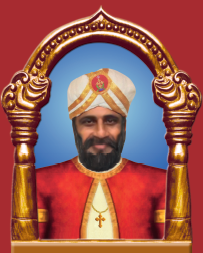
Thachil Mar Matthoo Tharakan (1741–1814) was a Saint Thomas Christian merchant, social leader and minister who played a key role in Kerala, especially in its Travancore and Cochin regions, in India towards the latter part of the 18th century and early 19th century. He relentlessly worked to bring about a reunification in his community which was divided into Catholic (Pazhayakūr) and Jacobite (Puthenkūr) after the Coonan Cross Oath of 1653. He organized his community against the colonialist attempts of Portuguese and played a prominent role in the assembly of Catholic Saint Thomas Christians at Angamāly that paved the way for the establishment of independent Syro-Malabar hierarchy.

Sarkaradevi Temple is one of the most important temples in South India. It is situated Chirayinkeezhu town in Thiruvananthapuram district. Tradition accords a remote antiquity to this temple. Its main deity is Bhadrakali. The Sarkaradevi Temple assumed a significant status for many reasons and rose to historical importance mainly with the introduction of the famous Kaliyoot festival by Anizham Thirunal Marthanda Varma, the Travancore sovereign, in 1748. The Sarkaradevi Temple have some basic attachment with Nakramcode Devi Temple which located in Avanavanchery, Attingal.

Uthrittathi Thirunal Gowri Parvathi Bayi (1802–1853) was the Regent of the Indian state of Travancore in 1815–1829. She succeeded her sister Maharani Gowri Lakshmi Bayi, till her regency was relinquished in favour of her nephew, Maharajah Swathi Thirunal.

The Travancore royal family was the ruling house of the Kingdom of Travancore.The Travancore royal family signed a treaty with the British in 1788, thereby adopting British dominance. Later, in 1805, they revised the treaty, leading to a diminution of royal authority and the loss of political independence for Travancore. They had to give up their ruling rights over the common people in 1949 when Travancore were forced to merge with Independent India and their political pension privileges were abolished in 1971.

The monarchy of Thailand is the constitutional form of government of the Thailand. The king of Thailand is the head of state and head of the ruling Royal House of Chakri.
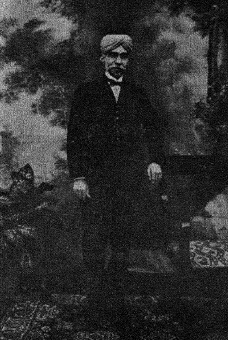
Khan Bahadur Sir Muhammad Habibullah KCSI KCIE was an Indian politician and administrator who served as the Diwan of Travancore from 1934 to 1936.
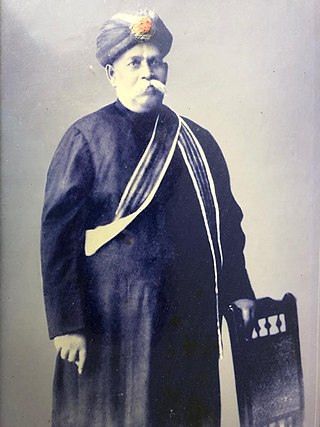
Diwan Bahadur Sir Veeraraghavapuram Nagam Aiya was an Indian pioneer, historian, civil servant, and chronicler who served as the Dewan in the erstwhile princely state of Travancore.

The Kerala Government Secretariat is the seat of administration of the Government of Kerala, in Thiruvananthapuram, housing important ministries and bureaucratic offices. It is the highest echelon of state administrative structure offering locus for the exercise of executive authority by the State Government of Kerala. The secretariat refers to the complex of departments. Its political heads are the ministers while the administrative heads are the Secretaries to the Government. The Government Secretariat is a popular landmark and located in heart of the Thiruvananthapuram City, in Narmada Road. The Secretariat complex was originally constructed as Durbar Hall for Travancore Kingdom.

Pillai, meaning Prince, is a title of nobility which can either refer to a ruling chief, members of the nobility, or junior princes of the royal family historically ranked immediately below the king. The oldest lineages of Pillais include not only Kshatriyas but also brahmins who took up the sword. From the early modern period, the title also came to be bestowed upon Savarna subjects by the Kings for services military or political, most of whom were of Nair origin.

In the United Kingdom, state funerals are usually reserved for monarchs. The most recent was the state funeral of Queen Elizabeth II on 19 September 2022.

The Esplanade of Sacrifice to the Heaven and Earth is an imperial altar situated south of the city of Huế, central Vietnam. It also known as the Nam Giao altar. It is dedicated to the heaven and earth. The complex was visited by the monarchs of the Nguyễn dynasty for annual ceremonies of prayer to Heaven.
This article needs additional or more specific categories .(May 2024) |